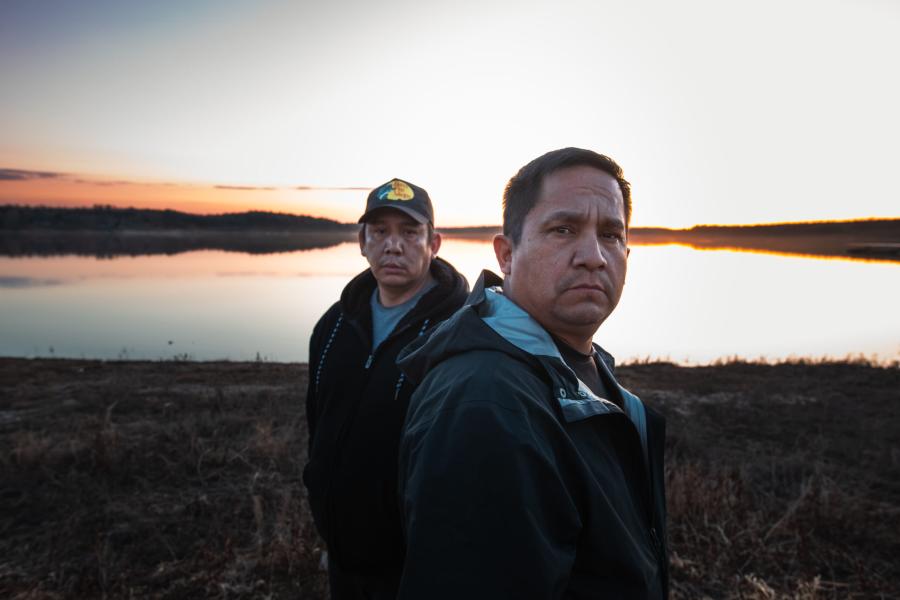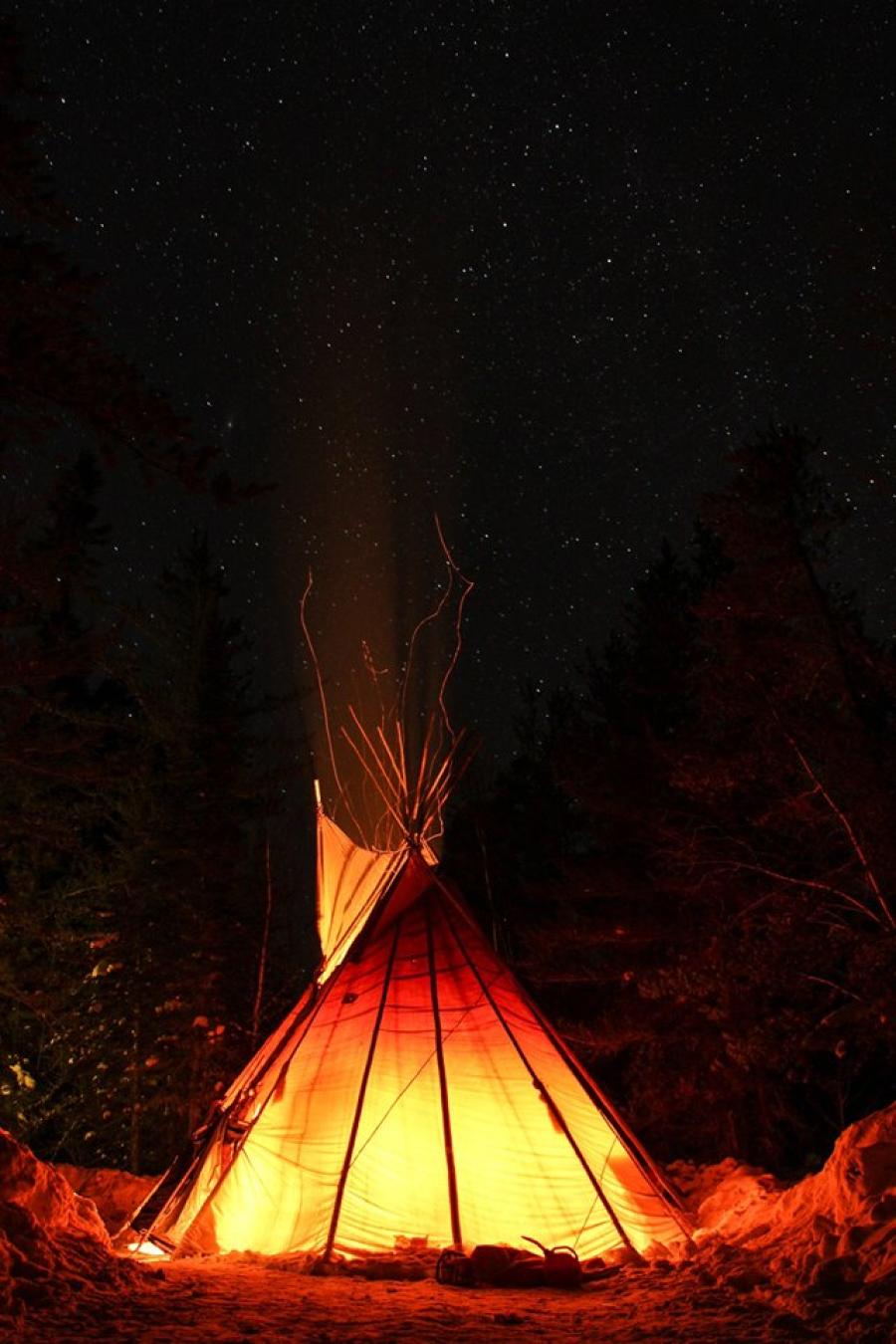The Innu
Recent months have seen growing criticism of the Environmental Impact Statement filed by Canada's Department of National Defence (DND) on its proposed expansion of the Goose Bay air base as a NATO center for low-level flight training. Scientists and environmental groups have attacked the report for glaring deficiencies, including a near-total lack of original research and conclusory and unsupported reassurances of minimal impact. As the Innu prepare for the long-awaited hearings, it appears that the Environmental Assessment Review Panel, an independent body appointed by the minister of the environment, will send the document back to DND with numerous deficiency statements and requests for new information. The issue has gained national attention, and Innu and their various support groups, including Cultural Survival, hope that the prolonged hearings will allow issues of reduced East-West tensions, the fall of the Berlin Wall, and an "open skies" policy in Europe to sink in to DND's cold war-ossified thought process.
The Algonquin
In early December 1989 the Algonquin of Barriere Lake received a four-month reprieve in the issuance of forest license agreements, known as "CAAFs" in Quebec legislation. Chief Jean-Maurice Matchewan and members of the band council have been actively negotiating with the Quebec Department of Forests, seeking to reach agreement on a forest management strategy that, while allowing for the logging, does not result in the wholesale loss of their land base through clear-cutting. Cultural Survival (Canada) is collecting funds to assist the Algonquin in their efforts.
James Bay
The largest hydroelectric facilities in Canada were built in the mid-1970s by the electrical corporation associated with the Quebec government. Approximately 11,000 km were flooded and a further 176,000 km were impacted by the dams. Hydro Quebec now plants to build more dams to generate cheap electricity for export to the New England states.
Although the Cree were parties to the original dams and were compensated for the loss of their land, opposition is growing among them to any new dams. Unforeseen impacts of the first dams include elevated mercury levels, which make fish unsafe for human consumption. According to the Grand Council of the Crees, they are experiencing the most significant mercury contamination in the northern hemisphere. Fluctuating water levels have also led to tragedy. Fluctuating water levels have also led to tragedy: in 1984, a release from the Canapiscau Reservoir drowned 10,000 caribou.
The new dams will, according to the US-based National Audubon Society, result in the destruction of the James Bay - and potentially the Hudson Bay - ecosystems within the next 50 years. The area is home to approximately 25,000 Cree, Inuit, and Naskapi people. Hearings took place through January and February before the National Energy Board, and opposition was expressed from a coalition of native, environmental, and energy organizations. The fight over the next phase of James Bay promises to be a long and exhausting ordeal.
Quebec Chiefs' Conference on the Environmental
Due to the increasing awareness of environmental threats in Quebec, the Quebec chiefs are planning their first environmental conference for the end of March in Ottawa. The conference will be timed to increase any necessary last-minute pressure in support of the Algonquin of Barriere Lake, Quebec, just prior to the deadline for issuing CAAFs. James Bay will also be a major focus of discussion. Russell Diabo, a member of Cultural Survival (Canada)'s Council of Advisors, works for the Algonquin of Barriere Lake and is organizing the gathering. The conference will also provide an opportunity for a formal book launch of the AFNs new publication, Drum Beat: Anger and Renewal in Indian Country. The book includes chapters by key participants in the struggles of Canada's First Nations. Copies of the book are available from the cultural Survival (Canada) office for $15 Canadian plus $4 postage and handling.
West Coast Nations Challenge New Zealand Forest Company
To commemorate the Commonwealth Games, a west coast totem pole was raised at the site of the New Zealand games in late January 1990. One hundred west coast peoples of the Nuuchah-nulth nation, representing 13 different native groups on the west coast of Vancouver Island, traveled to New Zealand to witness the event. But the visit was no entirely ceremonial. Chief Earl Macquinna George, hereditary chief of the Ahousaht people, along with nonnative environmental activist C.J. Hinke, protested the activities of a large New Zealand transnational logging company, Fletcher Challenge, which holds Tree Farm Licenses (TFLs) in a number of areas of hotly contested coastal and inland forest in British Columbia. The Ahousaht territory extends from the Atleo River on the northwest coast of Vancouver Island, north through Sulphur Passages to Shelter Inlet. This largely undisturbed area of forest-covered islands is in the region generally knows as Clayoquot Sound. Fletcher Challenge holds TRF 46, covering about 30 percent of the territory; other forest companies hold the rest. The company is worth in excess of NZ $60 billion and makes an annual profit of NZ $653 million. During the course of protests in June and July 1988, more than 100 people were arrested as they attempted to block the construction of a logging road along Sulphur Passage. Chief George was arrested at the instigation of Fletcher Challenge for stepping on his own land. C.J. Hinke served 37 days in a maximum-security prison, much of it in solitary, for his nonviolent obstruction of the road. Both men plan to camp on the front lawn of corporate head Hugh Fletcher in a bid to establish dialogue over land rights and forest harvesting practices.
the Japan Campaign
Cultural Survival (Canada) has sponsored a bilingual (English and Japanese) Canadian woman to work for the Japan Tropical Forest Action Network in Tokyo, at the request of Japanese environmental groups. The national election campaign in Japan provides an excellent opportunity to raise concern for the impact on indigenous peoples and the environment caused by Japan's overseas activities. Ninety percent of imports from the rapidly disappearing forest of the Malaysian states of Sarawak and Sabah go to Japan. Despite the arrest of hundreds of Penan and other Deyak peoples of the area - forest dwellers who depend on the forest for their lives - the Japanese public is virtually unaware of the crisis caused by their nation's voracious appetite for tropical timber.
The story is the same around the world. When Scott Paper abandoned plans to build a pulp and paper mill in Irian Jaya, Indonesia, Japanese companies moved in instead. But the behavior of Japanese interest overseas, whether in inappropriate "development assistance," drift-net fishing, or harvesting or rare and endangered species, is not an issue in Japan - where, ironically, most of the islands' own forests are protected.
Heather Souter, the woman sponsored by CSC, used to work for a consulting business dealing with Japanese interests in Vancouver, BC. She gave up her business in order to work in Tokyo to help with translation, as well as to provide strategic ideas and enhanced communication with North American support groups. The Japanese environmental movement is small and poorly funded, but extremely dedicated. Should further funding be available, and should the Japanese groups request her future assistance, CSC hopes to extend Heather's secondment to the Japanese groups after the national election campaign.
Canada-Tibet Committee
The small but determined Canadian population of Tibetans is preparing for a visit by the Dalai Lama to Ottawa in the fall of 1990. The official foreign policy in Canada, like that of the United States, has been to turn a blind eye to the plight of the Tibetan people and the real risk of their cultural extermination. Both governments believe the economic and strategic benefits of close ties with China outweigh any moral obligation to raise the issue of the systematic decimation of the Tibetan people. Of 6,254 Tibetan monasteries, only 10 remain. In the last 40 years, more than 1.2 million Tibetans out of a total population of 6 million have died as a direct result of Chinese occupation.
The Canada-Tibet Committee hopes to encourage the federal government to recognize the Dalai Lama as a head of state and treat his appearance as an official state visit. It is seeking support for its request that the Dalai Lama address the Canadian House of Commons (such treatment was denied the Dalai Lama in the United States, where his visit was termed "unofficial").
Gitskan and Wet'suewet'en
After years of costly and debilitating legal battles, the Gitskan and Wet'suewet'en Nation of British Columbia signed an agreement with the federal government in January 1990 binding both parties to negotiation process. The negotiations will involve nine Indian bands and 6,042 registered band members in the communities along the Skeena, Bulkley, and Kispiox rivers. Federal Minister of Indian Affairs and Northern Development Pierre Cadieux has characterized the Gitskan and Wet'suewet'en proposal as "unique and complex." If accepted the plan would lead to self-government based on traditional native law.
Article copyright Cultural Survival, Inc.



